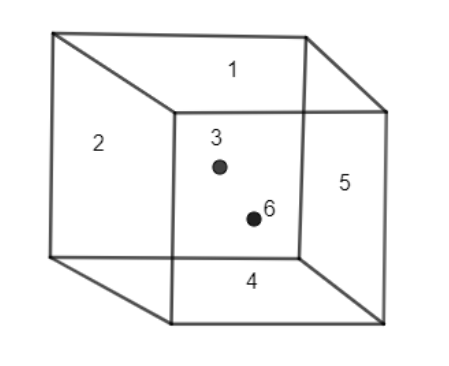
What number is opposite to 4?

A.6
B.5
C.2
D.1

Answer
488.7k+ views
Hint: In this question there are four figures given of a cube. We have to observe each cube and its adjacent faces of the cube to check the opposite faces of 4. The number which is present in the opposite faces of 4 in the cube.
Complete step by step solution:
Before going to the problem, we have to first understand the cube and its structure and also about its faces.
The figure of Cube is given below:

Above diagram shows a dice which is the shape of a cube. In there are two black dots that means first black dots is 3 which is present on back side and second black dot that is 6 which is present on front sides of the cube.
As we know, in a cube there are six faces as shown in the figure.
The die is in a cube shaped with face numbers (1, 2, 3, 4, 5 and 6).
Now as we know that in a cube for a particular face all faces are adjacent except the opposite face.
From the above information that is there are 4 figures from that we know,
From the first position of the dice, it is clear that 3,5 are neighbors of 1.
From the fourth position of the dice, it is clear that 2,3 are neighbors of 1.
From the second position of the dice, it is clear that 3,5 are neighbors of 4.
From the third position of the dice, it is clear that 2,3 are neighbors of 4.
Hence, the relation leads to the conclusion that number 1 is opposite to 4. From the first position of the dice, it is clear that 3,5 are neighbours of 1.
So, the correct option is “option D”.
Note: A cube is a symmetrical three-dimensional form made up of six equal squares that can be solid or hollow. All of the faces or sides of a cube have the same dimensions, the cube's plane angle is correct, each face meets the other four faces, and each of the vertices meets the three faces and three edges.
Complete step by step solution:
Before going to the problem, we have to first understand the cube and its structure and also about its faces.
The figure of Cube is given below:

Above diagram shows a dice which is the shape of a cube. In there are two black dots that means first black dots is 3 which is present on back side and second black dot that is 6 which is present on front sides of the cube.
As we know, in a cube there are six faces as shown in the figure.
The die is in a cube shaped with face numbers (1, 2, 3, 4, 5 and 6).
Now as we know that in a cube for a particular face all faces are adjacent except the opposite face.
From the above information that is there are 4 figures from that we know,
From the first position of the dice, it is clear that 3,5 are neighbors of 1.
From the fourth position of the dice, it is clear that 2,3 are neighbors of 1.
From the second position of the dice, it is clear that 3,5 are neighbors of 4.
From the third position of the dice, it is clear that 2,3 are neighbors of 4.
Hence, the relation leads to the conclusion that number 1 is opposite to 4. From the first position of the dice, it is clear that 3,5 are neighbours of 1.
So, the correct option is “option D”.
Note: A cube is a symmetrical three-dimensional form made up of six equal squares that can be solid or hollow. All of the faces or sides of a cube have the same dimensions, the cube's plane angle is correct, each face meets the other four faces, and each of the vertices meets the three faces and three edges.
Recently Updated Pages
Master Class 9 Social Science: Engaging Questions & Answers for Success

Master Class 9 Science: Engaging Questions & Answers for Success

Master Class 9 English: Engaging Questions & Answers for Success

Master Class 9 Maths: Engaging Questions & Answers for Success

Master Class 11 Economics: Engaging Questions & Answers for Success

Master Class 11 English: Engaging Questions & Answers for Success

Trending doubts
What is the Full Form of ISI and RAW

Golden Revolution is related to AFood production BOil class 9 social science CBSE

Which is the longest day and the shortest night in class 9 social science CBSE

Which are the Top 10 Largest States of India?

Why did Aurangzeb ban the playing of the pungi Answer class 9 english CBSE

Distinguish between the following Ferrous and nonferrous class 9 social science CBSE




